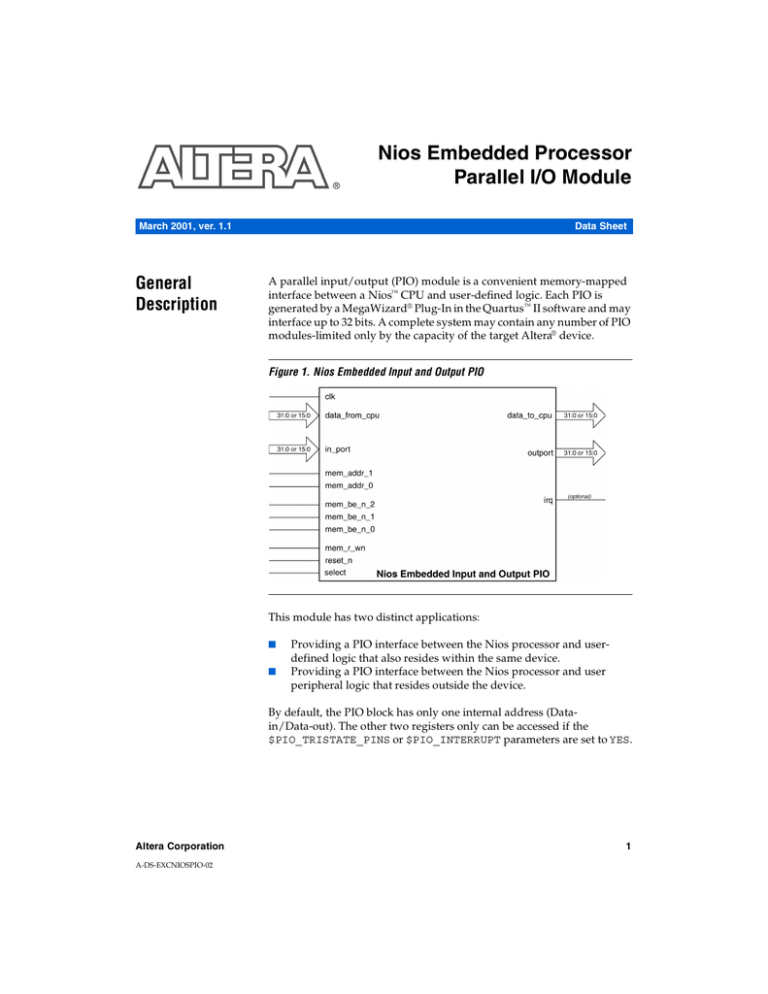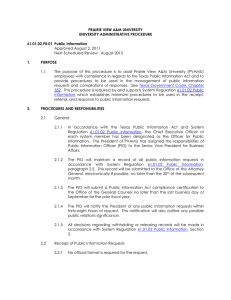
Nios Embedded Processor
Parallel I/O Module
March 2001, ver. 1.1
General
Description
Data Sheet
A parallel input/output (PIO) module is a convenient memory-mapped
interface between a Nios™ CPU and user-defined logic. Each PIO is
generated by a MegaWizard® Plug-In in the Quartus™ II software and may
interface up to 32 bits. A complete system may contain any number of PIO
modules-limited only by the capacity of the target Altera® device.
Figure 1. Nios Embedded Input and Output PIO
This module has two distinct applications:
■
■
Providing a PIO interface between the Nios processor and userdefined logic that also resides within the same device.
Providing a PIO interface between the Nios processor and user
peripheral logic that resides outside the device.
By default, the PIO block has only one internal address (Datain/Data-out). The other two registers only can be accessed if the
$PIO_TRISTATE_PINS or $PIO_INTERRUPT parameters are set to YES.
Altera Corporation
A-DS-EXCNIOSPIO-02
1
Nios Embedded Processor Parallel I/O Module
Figure 2. Nios Embedded Tri-State PIO
Figure 3. Nios Embedded Input-Only PIO
Figure 4. Nios Embedded Ouput-Only PIO
2
Altera Corporation
Nios Embedded Processor Parallel I/O Module
Table 1 .PIO Register Map
A1, A0
Register
Name
Variable Size (1 to 32 bits)
0
Data-in
Data-out
Data value currently on PIO inputs (read only)1
New value to drive on PIO outputs (write only)2
1
DataDir
Data Direction ( optional—tri-state only)3
Individual tri-state control each port bit. 1=out, 0=in
2
Int Mask
Interrupt Mask (optional)3 Per-bit interrupt request
(IRQ) enable/disable
Note:
(1)
(2)
(3)
PIO
Connections
Within a Device
Read-only register.
Write-only register.
Host-written control value. Can be read-back at any time.
Every bit in the PIO block is associated with an input register and output
register. Writing to a PIO output register sets a value on the PIO output
and reading from a PIO input register reads the current value from the
PIO inputs. The input and output connections are distinct.
By default, the PIO block has both input and output pins. The parameter
$PIO_INPUT_PINS controls the input connections and the parameter
$PIO_OUTPUT_PINS controls the output connections. These parameters
accept true or false as values.
PIO
Connections
Outside a
Device
The PIO block can have bidirectional pins instead of separate input and
output pins, i.e., the outputs can only connect to external device pins.
To use the PIO block with tri-state buffers in devices, the
PIO_TRISTATE_PINS parameter should be set to true at compile-time.
In this case, the PIO register set also includes a data-direction register
for software control of the output drivers.
If you set the $PIO_TRISTATE_PINS parameter to true, this module's
in_port and out_port connections will be replaced by a single n-bit
connection named bidir_port. It is the designer's responsibility to
connect all the individual bits of bidir_port to an I/O port on the
top-level design.
Variable Width
Altera Corporation
The PIO block width provides between 1 and 32 input pins and between
1 and 32 output pins. These I/O pins may also be configured to provide a
bidirectional interface.
3
Nios Embedded Processor Parallel I/O Module
Edge Capture
The PIO edge capture detects a transition on an input to the PIO and sets
a corresponding bit in the CPU-readable edge capture register. The edge
capture parameter may be set to one of the following values:
■
■
■
■
Rising—Detects the transition from logical 0 to logical 1.
Falling—Detects the transition from logical 1 to logical 0.
Any—Detects any logic level transition.
None—Detect only the logic level.
1
None is the default value.
A write-operation to the edge-capture register clears all bits.
Interrupt
Control
The PIO interrupt control feature may be enabled to create a CPU
interrupt. By default, the PIO block does not generate an interrupt, and
has no interrupt-control logic or registers. The PIO interrupt parameter
can be set to one of the following values:
■
■
Level-Generate an interrupt when a PIO input logic level is detected.
Edge-Generate an interrupt when a PIO input logic level transition is
detected.
The PIO block includes both an irq-pin to the CPU and an internal
interrupt-masking register when the interrupt control feature is used. The
edge feature is only available if the PIO edge capture parameter is
enabled.
PIO Software
Routines
f
101 Innovation Drive
San Jose, CA 95134
(408) 544-7000
http://www.altera.com
Applications Hotline:
(800) 800-EPLD
Customer Marketing:
(408) 544-7104
Literature Services:
lit_req@altera.com
If there is one or more PIO peripheral present in the Nios system, the PIO
peripheral software routines are available in the Nios library (.lib folder
in the custom software development kit).
For more information regarding software routine calls and custom
software development kits, please refer to the Nios Software Development
Reference Manual.
Altera, APEX, ACEX, FLEX, MegaWizard, and Nios are trademarks and/or service marks of Altera
Corporation in the United States and other countries. Altera acknowledges the trademarks of other
organizations for their respective products or services mentioned in this document. Altera products are
protected under numerous U.S. and foreign patents and pending applications, maskwork rights, and
copyrights. Altera warrants performance of its semiconductor products to current specifications in accordance
with Altera’s standard warranty, but reserves the right to make changes to any products and services at any
time without notice. Altera assumes no responsibility or liability arising out of the application
or use of any information, product, or service described herein except as expressly agreed to
in writing by Altera Corporation. Altera customers are advised to obtain the latest version of
device specifications before relying on any published information and before placing orders
for products or services.
Copyright 2001 Altera Corporation. All rights reserved.
4
Altera Corporation
Printed on Recycled Paper.



